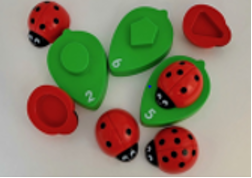Center activities are commonplace in early childhood classrooms. Typically, materials for the activities are placed on various tables or in sections of a room where small groups of children can sit. In some cases, teachers give specific directions about what to do at the center (for example, to group bears of the same color or size together in the same bowl). In other cases, children have more flexibility and are limited only by the nature of the materials. Often each table has a different activity and children move from one activity to another.
Center activities involving math have many benefits. Children learn how to work independently and to collaborate with peers as they practice math skills and deepen their math understanding. Teachers can attend to individuals or small groups of children during the activities.
But some math center activities are more productive than others. This article offers tips for choosing and developing effective math center activities using materials commonly found in early childhood settings. Explore examples of high-quality math center activities.
Tips for Setting Up Effective Math Center Activities
- Keep the instructions simple. You can’t always count on young children to remember several steps at one time. For example, there are too many steps in an activity that asks children to paint the macaroni three different colors, then sort the macaroni by color into bowls, and finally to make a circle with one color of macaroni, a triangle with another, and a square with the third color. Plan activities so children only need to remember one or two steps at a time (as in Hidden Objects) or break up a longer series of steps with periods of work time (like Draw Your Building).
- Make sure the math learning goal is central to the activity. Teachers can provide direction and monitoring to ensure that children engage in math. Placing small bowls and different colored and sized bears in a center does not necessarily lead to sorting. Children might have fun with the bears, but might not sort or count the bears, depending on the math goal. Create activities where math is required to complete the activity (for example, Speed Sorting).
 Avoid activities that can be completed without doing math. For example, in the pictured ladybug activity children can match shapes through trial and error instead of counting and exploring numbers.
Avoid activities that can be completed without doing math. For example, in the pictured ladybug activity children can match shapes through trial and error instead of counting and exploring numbers.
- Choose collaborative activities in addition to competitive games. Competitive games can lead to squabbles that distract from learning, especially when teachers are not constantly involved with the activity. Collaborative activities can be done in centers, and they teach children important social skills like turn-taking (see Follow the Path). Working together with blocks to build a structure (as in Build Together) offers children opportunities to talk and plan with each other without competing.
- Connect the activities to math concepts taught during more structured lessons. For example, if the class is working on counting, spatial relations, or measurement during whole group time, choose center activities that give children opportunities to extend and practice counting, spatial relations, or measurement skills.
Make the Most of Math Center Time
Center activities offer advantages that come when children learn in small groups. Small group work means that it is easier for the teacher to learn what children really understand about the concepts. Children get to talk in smaller groups of peers and interact with each other to build positive peer social skills.
To get the most learning out of math centers, teachers can circulate the room and engage children in conversations focused on the math:
- “How many blocks are in your tower? How many would you have if Maria added one? How many blocks do you think it will take for the tower to fall over?”
- If children completed the task quickly and with ease, suggest a more difficult version: “Can you make a pattern using all three shapes/colors?”
- If children are struggling with the task, give a hint or break the task down into smaller steps: “Why don’t you copy just this part of the building?”
Centers can be a great opportunity to find out more about what your students know and what they are still learning.